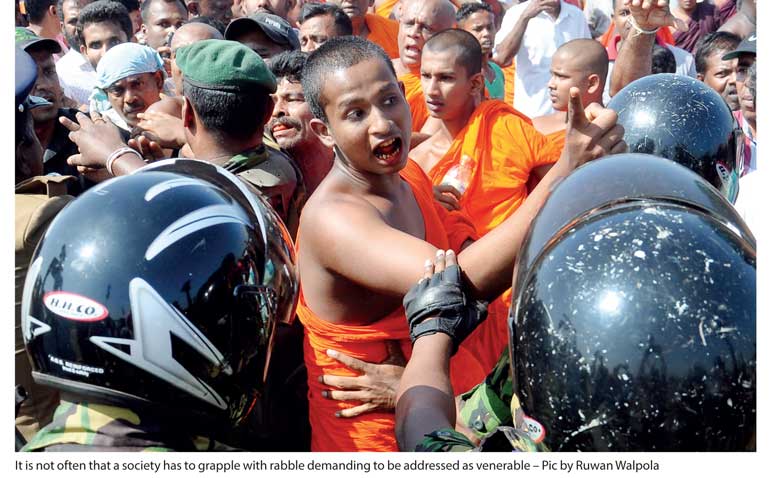Saturday Nov 15, 2025
Saturday Nov 15, 2025
Wednesday, 28 June 2017 00:00 - - {{hitsCtrl.values.hits}}
 “If the field was not fertile, the crop would be poor, and the farmer must naturally be unhappy about it. If the Sangha was impure, the charity bestowed on them would bring poor results, and the donors must naturally be unhappy about it. This was one reason why kings and the people were so anxious about the unblemished purity of the Sangha” – Venerable Dr. Walpola Rahula Thero
“If the field was not fertile, the crop would be poor, and the farmer must naturally be unhappy about it. If the Sangha was impure, the charity bestowed on them would bring poor results, and the donors must naturally be unhappy about it. This was one reason why kings and the people were so anxious about the unblemished purity of the Sangha” – Venerable Dr. Walpola Rahula Thero
The Asgiriya statement is an unambiguous manifesto of Sinhala Buddhist clerical fascism. It is an ecclesiastical indenture of priestly cunning packed with parochial hubris.
The demands made therein contradict all ethical requirements of a modern democratic society. A priestly class that considers itself privileged and above the law is irreconcilable with moral and social imperatives of contemporary times.
It is the duty and responsibility of all of us, Buddhists, to stop these bullies in their tracks. They have dealt a blow to our democracy. Instead of deceiving ourselves that the bully has got bloody knuckles, we must amputate the vile arm of the bully. We must unravel the politics behind this putsch of pietism – the Asgiriya power play.
The Government was taken unawares. It was a secretly-hatched, cleverly-choreographed theatre that made the Government look foolish and inept. Its purpose was to clear the way for the Monk Galagoda Aththe Gnanasara who was evading arrest, to surrender to court on the next day and to be released immediately thereafter. As evidenced by unfolding events it was a successful stratagem.
The Asgiriya exercise is also a political power play. Its caption is a mailed fist at the elected Government. “We the Karaka Sangha Sabah in our devotion to the Sasana serve this kind notice on the Government.” It has defied the Government’s rights to legislate. Don’t enact legislation that we do not endorse.
This clerical revolt would have never occurred under Mahinda Rajapaksa – the redeemer of the Sinhala Buddhist people. The Sangha had a Faustian compact with him. As head of a patrimonial state, he assiduously cultivated a patron client relationship with the ‘Sangha’. They were saffron-robed ‘squires’ in the court of not a charismatic leader but an iconic leader. They recognised his capacity for coercive persuasion but were immensely appreciative of his efforts to win allegiance by distributing fiefs and benefits in return for loyalty.
The genius of Mahinda Rajapaksa was his perfection of a medieval order of governance in the 21st century during the five post war years of his presidency. Absolute rule and patrimonial politics complimented each other. There emerged a court etiquette that the Sangha observed with religious care.
The saffron robe was once regarded as a declaration that the wearer has embarked on the path from home to homelessness. Mahinda provided them with a comfortable hostel in-between. The Asgiriya monks demand that Maithree and Ranil extend their stay in Mahinda’s hostel.
Alas, the two Upasakas – Sirisena and Wickremesinghe – are made of lesser stuff. Their mistake was to interpret their successful 8 January 2015 revolt as an accomplished revolution. They are now in a deadly struggle to consolidate their achievements. They have a problem. The two are not agreed on what their achievements are. They are equally confused and do not know, if they have achieved anything at all.
Call it what you may. Protest, statement, edict or whatever. Its contents indicate that it is a backlash against modernity. Knowing their capricious nature it is both predictable and understandable.
It is not often that a society has to grapple with rabble demanding to be addressed as venerable. As a Buddhist, though not perfect in practice but with a clear grasp of what the Buddha preached and an utter contempt for what some of the Sangha practice, this writer wishes to address this issue of the sanctity of the robe and the depravity of the wearer.
Despite the grand rhetoric concerning their antecedents, the present day Sangha institution took shape during the reign of Kirti Sri  Rajasinghe (1747-82). He revived Buddhism in the hill kingdom by reestablishing higher ordination and appointing Venerable Welivitiya Saranakara as the first Sangharaja who is the source of all authority that the two monasteries claim today.
Rajasinghe (1747-82). He revived Buddhism in the hill kingdom by reestablishing higher ordination and appointing Venerable Welivitiya Saranakara as the first Sangharaja who is the source of all authority that the two monasteries claim today.
When Keerthi Sri Rajasinghe ascended the throne, the vast majority of the Buddhist priestly class led a quasi-religious life style. They were known as “ganinnanse” or semi-monk. A title that aptly fits the monk Galagoda Aththe Gnanasara now in the eye of the ecclesiastical storm.
The restoration of Buddhism involved the transfer of huge economic assets in the form of land grants from the king to temples. To this day these economic assets are jealously guarded by priestly cabals whose membership are confined to a few Kandyan families in the Central Province and mostly from the Matale District.
The two monasteries Asgiriya and Malwatte are prototypical feudal remnants resisting modernity with militant piety. That said, we ignore them at our peril.
Dr. Rajitha Senaratne elected from Kalutara promised a considered response to the Asgiriya encyclical. In stark contrast S.B. Dissanayake defeated in Kandy and nominated in the National List offered abject surrender. “If the Maha Nayake Theros and the highest of clergy in the Sangha Council are frustrated in any sense with the Government, I humbly seek their apology.” Biting the dust at the last election, his ear seems glued to the ground.
Religion is deeply rooted in predominantly Buddhist countries such as Myanmar, Thailand and Sri Lanka. In these societies religious influence is pervasive and therefore priestly influence impacts all institutions.
The priests have over time, developed their own survival modes that have no relevance to pristine religious teachings. Instead they are mostly focused on worldly affairs and entitlements of the Sangha order.
Under monarchs they were advisers to royals. They were power brokers in court. They were feudal landlords who owned and managed huge tracts of vast wealth. Celibacy was observed in the breach. A common custom among the powerful monks is to ordain the offspring of their sisters and brothers to ensure the succession to temple property remain in the family. The possibility of offspring in the guise of nephew is not to be ruled out. It is corrupt to its core but manages to keep a lid on its villainy.
Venerable Dr. Walpola Rahula in his book ‘ History of Buddhism in Ceylon’ provides a succinct description of the beginnings of Buddhism and how it became the national ethos, and the State religion of the island.
“Buddhism began as an intellectual and ethical movement in the sixth century B.C., with the first sermon preached by the Buddha to the five ascetics at Isipathana near Banaras. It spread gradually during the lifetime of the Buddha along the Gangetic valley and found its way into several kingdoms in North India between the Vindhya Mountains and the Himalayas. Kings and Ministers, Bankers and Merchants, Brahmins and Peasants became the followers of this new teaching which was a revolt against some of the accepted theories and practices of the day.”
Dr. Rahula proceeds to explain the roots of our present day conundrum. Asoka was the first king to adopt Buddhism as the State religion two centuries after the death of the Buddha. Asoka did so by edicts that prescribed Buddhist practices. It was Buddhist governance by an enlightened monarch. But in Sri Lanka, it became the State religion from the day of its introduction to the island.
Then he points to our march of folly. “We have to admit that from the day that Buddhism was adopted as a state religion, it began to lose its original spirit of renunciation and simplicity, and gradually developed in to an ecclesiastical organisation with its numerous duties, religious, political and social. It is impossible for any religion, when it becomes an organised body, to continue in its original form. It has to change with the times if it is to maintain its power and prestige. ‘Adapt or perish’ is nature’s inexorable imperative.”
Professor Yasmin Gooneratne in her book ‘Relative Merits; A personal memoir of the Bandaranaike Family’ has an interesting anecdote. SWRD tells his cousin Samuel about the most Venerable Budharakkitha: ‘He fasts by day and feasts by night.’
The more things change, the more they remain the same.